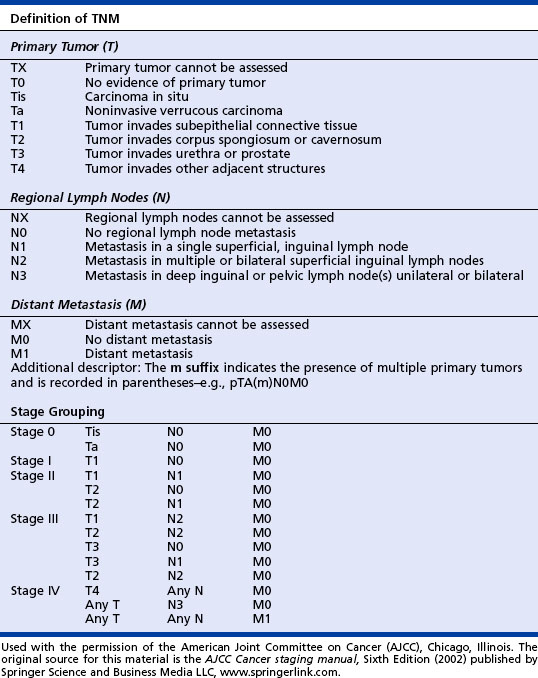Genitourinary Cancers
Bladder Cancer
DEFINITION
Bladder cancer is the fourth most common cancer in men and the ninth most common cancer in women. Alterations in deoxyribonucleic acid from viruses, chemical carcinogens, or exposure to other chemical agents will influence who has bladder cancer. Bladder cancer is often described as a field-change disease, which involves the urothelium from the renal pelvis to the urethra. Metastasis occurs through the lymphatic system to the regional lymph nodes. Bladder cancer may also metastasize to the bones, liver, and lungs.
ETIOLOGY AND RISK FACTORS
Risk factors include the following:
• Exposure to industrial chemicals
• Patients with indwelling catheters, chronic urinary infections, and renal calculi may be prone to development of the disease.
• Cyclophosphamide administered over an extended period of time, in particular to patients with upper tract bladder outlet obstruction, has been reported to increase the incidence of bladder cancer.
TREATMENT
Medical Treatment
Often for high-grade lesions or lesions suspected of recurring, intravesical therapy may be warranted. Immunotherapy such as Bacille Calmette-Guérin (BCG) or chemotherapy is used to decrease recurrence, prevent progression, and eradicate the residual disease after transurethral resection. Intravesical BCG is the standard treatment for superficial bladder cancer. Treatment with BCG is weekly for 6 weeks, and maintenance therapy is usually monthly or every 3 months. Subcutaneous interferon may be used in patients who have failed BCG. Interferon response rates have been reported at 20% to 43%. Interferon may also be effective in preventing recurrence of superficial disease. Intravesical chemotherapy is generally given for low-grade disease. Mitomycin, doxorubicin, or thiotepa is recommended to be administered at surgery or at least within 6 hours of resection. The role of gene therapy for superficial bladder cancer is currently being investigated.
Green F.L., Page D.L., Fleming I.D., et al. AJCC cancer staging manual, 6th ed. New York: Springer-Verlag, 2002.
Grossfield G., Carroll P. Urothelial carcinoma: cancers of the bladder, ureter and renal pelvis. In: Tanagho E., McAninch J. Smith’s general urology. 6th ed. New York: McGraw-Hill; 2004:324–345.
Jemal A., Siegel R., Ward E., et al. Cancer statistics, 2007. CA: A Cancer Journal for Clinicians. 2007;57:43–66.
Lamm D.L., McGee W., Hale K. Bladder cancer: current optimal intravesical treatment. Urologic Nursing. 2005;25:323–333.
Malkowicz S. Management of superficial bladder cancer. In: Walsh P.C., Retik A.B., Vaughan E.D., et al. Campbell’s urology. 8th ed. Philadelphia: W. B. Saunders; 2002:2785–2802.
Nieder A.M., Brausi M., Lamm D., et al. Management of stage 1 tumors of the bladder: international consensus panel. Urology. 2005;66(6A Suppl):108–125. In M. Soloway (Ed)
Raghavan D., Skinner E. Genitourinary cancer in the elderly. Seminars in Oncology. 2004;31:249–263.
Schoenberg M. Management of invasive and metastatic bladder cancer. In: Walsh P.C., Retik A.B., Vaughan E.D., et al. Campbell’s urology. 8th ed. Philadelphia: W. B. Saunders; 2002:2803–2817.
Shipley W., Kaufman D., McDougal W., et al. Cancer of the bladder, urether, and renal pelvis. In: DeVita V., Hellman S., Rosenberg S. Cancer principles and practice. 7th ed. Philadelphia: Lippincott Williams & Wilkins; 2005:1168–1192.
Skinner D., Stein J., Ross R., et al. Cancer of the bladder. In: Gillenwater J.Y., Grayhack J.T., Howards S.S., et al. Adult and pediatric urology. 4th ed. Philadelphia: Lippincott Williams & Wilkins; 2002:1298–1362.
Wood L., Clabrese D. Bladder and renal cancers. In: Yarbro C., Frogge M., Goodman M. Cancer nursing. 6th ed. Boston: Jones & Bartlett; 2005:1005–1021.
Penile Cancer
ETIOLOGY AND RISK FACTORS
The etiology of penile carcinoma is controversial. Risk factors include the following:
• Increasing age—most diagnoses are made after 60 years of age.
• The presence of a foreskin. It is rare to find cancer of the penis in a man who was circumcised at birth
• Phimosis (tightness of the foreskin that prevents retraction)
• Exposure to human papillomavirus (HPV)
• Prior history of sexually transmitted diseases, including human immunodeficiency virus
• Poor personal hygiene practices
• Psoriasis patients treated with ultraviolet radiation in combination with oral 8-methoxypsoralen
• Premalignant lesions associated with squamous cell carcinoma of the penis include the following:
DIAGNOSTIC WORKUP
The following diagnostic tools are crucial in the diagnosis and staging of penile cancer:
TREATMENT
• Small superficial tumors: Mohs’ micrographic surgery, laser beam therapy, radiation therapy, and in some cases, topical fluorouracil
• Tumors involving only the prepuce: circumcision
• Invasive tumors: partial or total penectomy
• Advanced stages: single-agent or combination chemotherapy
• Approximately half of the patients with penile cancer present with lymphadenopathy.
Brosman S.A. Penile cancer. Retrieved on June 13, 2006 from http://www.emedicine.com/med/topic3046.htm, 2006.
Green F.L., Page D.L., Fleming I.D., et al. AJCC cancer staging manual, 6th Ed. New York: Springer-Verlag, 2002.
Jemal A., Siegel R., Ward E., et al. Cancer statistics, 2007. CA: A Cancer Journal for Clinicians. 2007;57:43–66.
Misra S., Chaturvedi A., Misra N. Penile carcinoma: a challenge for the developing world. The Lancet. 2004;5:240–247.
Presti J. Genital tumors. In: Tanagho E., McAninch J. Smith’s general urology. 6th Ed. New York: McGraw-Hill; 2004:386–399.
Razdan S., Gomella L. Cancer of the urethra and pelvis. In: DeVita V., Hellman S., Rosenberg S. Cancer principles and practice. 7th ed. Philadelphia: Lippincott Williams & Wilkins; 2005:1260–1267.
Sanchez-Ortiz R., Pettaway C. National history, management, and surveillance of recurrent squamous cell penile carcinoma: a risk-based approach. Urological Clinics of North America. 2003;30:853–867.
Stotts R.C. Cancers of the prostate, penis, and testicles: epidemiology, prevention, and treatment. Nursing Clinics of North America. 2004;39:327–340.
Vogelzang N.J., Scardina P.T., Shipley W.U., et al. Comprehensive textbook of genitourinary oncology. In: Vogelzang N.J., Scardino P.T., Shipley W.U., et al. Penile cancer: clinical signs and symptoms. Philadelphia: Lippincott Williams & Wilkins; 2006:805–830.
Stay updated, free articles. Join our Telegram channel

Full access? Get Clinical Tree





